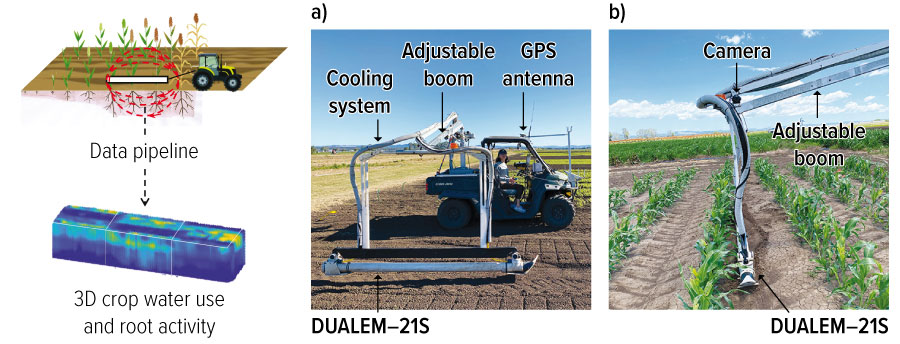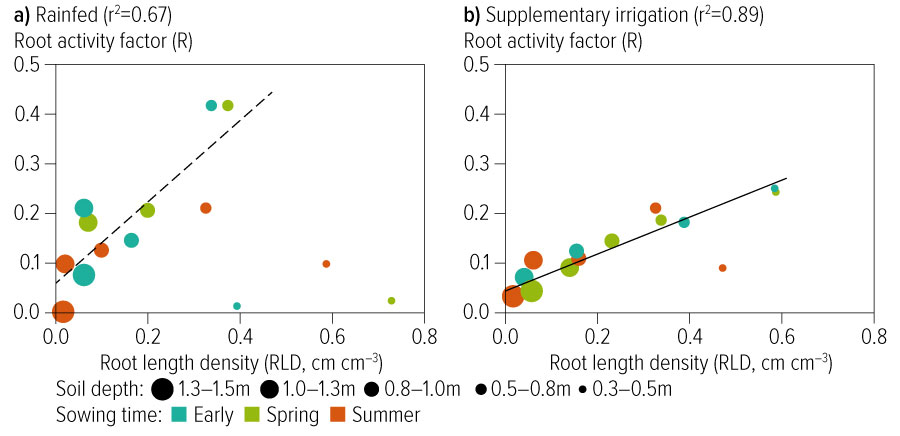Australia
September 12, 2024
.jpg)
Dr Dongxue Zhao and QAAFI’s ‘Root mobile’ produce 3D root activity maps in the field at a farm on the Darling Downs, Queensland.
Photo: Professor Daniel Rodriguez
New developments in phenomic tools are shedding light on the finer dynamic interactions of crop roots and yield that could boost productivity and drought.
Given that grain production in Australia is mainly limited by water availability, it is rather perplexing how little is known about the rooting system – the most critical plant organ to access soil water and nutrients.
The architecture, anatomy and function of the root system offer untapped opportunities for crop improvement and productivity gains in the grains industry.
However, root traits are hard to measure and the lack of quick, cheap, accurate and functional root phenotyping approaches in the field has limited the capacity of breeding, agronomy and precision agriculture to develop valuable traits and products.
We do know that the crop’s genetic background and the environment (soil, climate, management) interact to alter the architecture of the rooting system, or root phenotype. However, rarely have studies on root architecture been able to relate these differences into valuable information such as differences in root function – and therefore implications for yield, or yield stability in the field.
Lack of success is due to the complexity and limited understanding of the relationship between root form, root function and grain yield. A major bottleneck has been the fact that characterisation of the below-ground parts of crops is laborious, expensive and subject to large errors, as usually only a limited part of the rooting system can be sampled.
Root studies are usually done by growing single plants in pots, root chambers or tubes, or destructively extracting soil samples containing roots from the field. Another problem has been that research appears stubbornly focused on trying to visualise root architecture, ignoring the rather weak and highly variable relationship between root form and root function.
Also, the predominant focus of these approaches has been limited to just measuring the mean value of a trait – for example, rooting depth. This overlooks the fact that the root system is highly responsive to the environment, and that different genotypes show different capacity to adapt to their environment when under stress.
Aiming to alleviate this bottleneck, a new GRDC-invested project being led by the University of Queensland’s Queensland Alliance for Agriculture and Food Innovation (QAAFI) is delivering root phenotyping tools to enable valuable crop root structure and function traits to be measured non-destructively with at least 15 per cent greater accuracy, cost-effectiveness, or throughput than current methods.
The project brings together a multidisciplinary team of national and international researchers from QAAFI, the University of Queensland, the Western Australian Department of Primary Industries Research and Development (DPIRD), CSIRO and the Leibniz Institute of Plant Genetics and Crop Plant Research (IPK) in Germany, to work in collaboration with seed companies (Pioneer Seeds Australia, Pacific Seeds, Australian Grain Technologies and LongReach Plant Breeders), and providers of digital and precision agriculture services (Airborn Insight and DataFarming), to deliver actionable solutions to industry and growers.
The project will also build capability for the Australian industry through the training of postgraduate and postdoctoral scientists in the use of these new approaches for examining functional crop rooting traits across highly contrasting environments.
Novel approach
The project’s approach is integrating new, functional high-throughput phenotyping tools with the trait pipeline approach applied in pre-breeding programs and commercial seed companies, where there is simultaneous development of screening methods and evaluation of valuable traits in relevant germplasm. Applications for agronomy and precision agriculture will be also explored.
In our approach, we combine time-lapsed electromagnetic induction (EMI) surveys, drone imagery, crop ecophysiology principles and machine-learning techniques to build 2D and 3D representations of root growth and activity in the soil profile.
The methods were developed within the GRDC project ‘Optimising sorghum agronomy in the northern grains region’ and applied to map plant-available water capacity in growers’ paddocks in another GRDC-invested project.
Figure 1: QAAFI’s high-throughput functional phenotyping of rooting systems being applied at a sorghum trial
 Source: Dongxue Zhao, University of Queensland.
Source: Dongxue Zhao, University of Queensland.
In principle, an EMI unit is dragged over the soil in between rows (Figure 1) to derive 3D maps of crop water use in the soil profile that, together with the use of drone imagery and APSIM modelling, are used to calculate an index of ‘root activity’ for each soil layer, down to the maximum rooting depth.
We have shown that this index of root activity was highly related to important root traits such as the extent of root length density in the soil profile – obtained by soil coring – across a wide range of environmental conditions (Figure 2). Importantly, our results also show that differences in root traits between commercial sorghum hybrids were associated with differences in yield and yield stability.
Figure 2: Relationship between the EMI-derived root activity factor (R: y axis) and root length density (RLD: x axis) in the soil profile, for the sorghum variety MR Buster grown under rainfed, supplementary irrigation, and three times of sowing: early, spring and summer at Nangwee, Queensland. The size of the dots represents the soil layer.
 Source: Dongxue Zhao, QAAFI
Source: Dongxue Zhao, QAAFI
Our approach to high-throughput functional root phenotyping in the field is quick, cheap and accurate, and when applied across contrasting growing environments not only allows researchers to assess the average value of a root trait but also its variability (in other words, plasticity) in response to changes in environmental conditions or management practices such as plant density, row configuration, fertilisation, soil amelioration or irrigation.
This is the first time that a root phenotyping approach in the field has allowed us to explain changes in crop yield, yield components and their stability, offering an opportunity to overcome the present root phenotyping bottleneck in cereals for breeding and agronomy.
Validation of these new sensing techniques, and collaboration with root anatomy experts from IPK in Germany, will open opportunities to examine further below-ground crop root traits of interest to boost crop performance, such as maximum rooting depth, the rate of root advancing front, shallow to deep water use, root hydraulic conductivity and root anatomy traits.
Deployment
The project team is working closely with wheat and sorghum pre-breeding programs and breeding companies, as well as providers of digital agriculture services, providing a clear pathway to market. This ensures that project outputs will be relevant, valuable and actionable by/to industry, and adoption accelerated.
More information: Professor Daniel Rodriguez, d.rodriguez@uq.edu.au
Supplement: Analytics, Data and Phenomics, July-August 2024
Region: North
Date published: 12 Sep 2024
Authors: Professor Daniel Rodriguez, Dr Dongxue Zhao, Associate Professor Karine Chenu, Professor Lee Hickey, Professor David Jordan, Professor Emma Mace, Professor Hannah Schneider, Associate Professor Andries Potgieter, Dr Vijaya Singh, Dr Anton Wasson, Dr Hammad Khan
GRDC codes